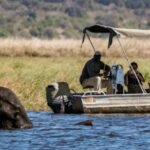- Arusha, United Republic of Tanzania
- info@olodiafricanpathways.com
- +255 787 052 187
Olodi African Pathways Photography

Selous Game Reserve
Selous Game Reserve is a magnificent wildlife sanctuary located in southern Tanzania. Covering an impressive area of approximately 50,000 square kilometers, it is one of the largest game reserves in Africa and a UNESCO World Heritage Site. Named after the famous British explorer and conservationist Frederick Selous, the reserve is renowned for its abundant wildlife, pristine landscapes, and untouched wilderness.
Wildlife in Selous
There are a huge number of wildlife animals you can find when on safari in Selous game reserve. Lions, leopards, hippos and crocodiles live in Selous. You can spot endangered black rhinos, hard-to-find East African wild dogs as well as hyenas. Cape buffaloes, Masai giraffes, wildebeests and zebras live here too, the latter two are known for their great migration! And of course, it is home to impalas, large numbers of Lichtenstein’s hartebeests, waterbucks and sable antelope in addition to elands and bushbucks. It is much quieter here than in the other parks, so you definitely have the chance of a unique experience during your Tanzania vacation! The Selous game reserve was previously home to a very large number of many African bush elephants. Unfortunately, numbers have greatly reduced because of excessive poaching happening in the game reserve.
Birds in the Selous Game Reserve
The Selous game reserve is home to thousands of birds. Scientists have recorded over 445 different bird species that live in the various habitats within the Selous. The giant kingfishers, the pink-backed pelican, as well as the African skimmer, live for instance near the lake areas. Along the sandbanks, you will see the white-fronted bee-eater, fish eagle, carmine, ibises and palm nut vultures. The purple-crested turaco, yellow-billed stork, trumpeter hornbill, white-crowned spur-winged plovers, malachite kingfishers and various small waders are among the other water birds that you can see in Selous Game Reserve, as well migrant species.
Most common animals in Selous
- African bush elephants
- Lions
- Leopards
- Hippos
- Crocodiles
- Black rhinos
- East African wild dogs
- Hyenas
- Cape buffaloes
- Masai giraffes
- Zebras
Selous landscape
The Rufiji River, which flows into the Indian Ocean opposite Mafia Island, crosses the entire reserve. Around this river is a swampy area with an enormous amount of crocodiles. The Stiegler Gorge is a special attraction here. This is a gap 100 meters deep and 100 meters wide.
Facts about Selous
- Renamed “Nyerere National Park”
- UNESCO World Heritage Site
- The total area of 50,000 km²
Boat tour in Selous
Selous is also one of the few national parks where you can go on a boat safari. It is also one of the few parks that allow walking safari. It is an ideal trip if you want to enjoy the beautiful scenery of the Rufiji River with its many hippos, crocodiles and beautiful bird life. The sunset can also be stunning from the boat- there is nothing quite like the serenity of the river while the sun dips below the horizon.
Best time to visit
The best time to visit Selous is the dry season from June to October. The wildlife is easier to spot because the vegetation isn’t thick and the wild animals have gathered around the known water sources. Subsequent towards the end of the heavy rain, the roads are extremely impassable and many of the camps are closed as the wet season comes to an end. A good time to observe the scarce wild dogs is during their denning phase which begins in June and lasts till August.
Travel time to Ngorongoro Conservation Area
- Arusha to Ngorongoro Conservation Area: 3 hours
- Ngorongoro Conservation Area to Serengeti National Park: 2 hours drive.
- Ngorongoro Conservation Area to Lake Manyara: 1-hour drive.
- Ngorongoro to Tarangire: 2 hours’ drive
